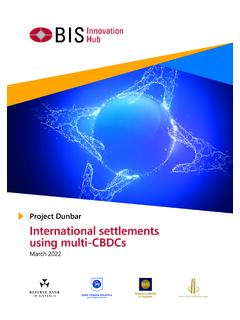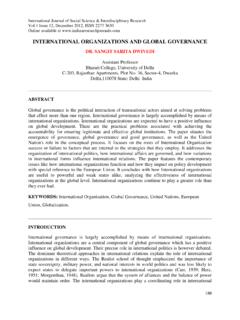Transcription of Covid-19 and cyber risk in the financial sector
1 BIS Bulletin No 37 Covid-19 and cyber risk in the financial sector I aki Aldasoro, Jon Frost, Leonardo Gambacorta and David Whyte 14 January 2021 BIS Bulletins are written by staff members of the Bank for international Settlements, and from time to time by other economists, and are published by the Bank. The papers are on subjects of topical interest and are technical in character. The views expressed in them are those of their authors and not necessarily the views of the BIS. The authors are grateful to Giulio Cornelli for excellent analysis and research assistance, and to Louisa Wagner for administrative support. The editor of the BIS Bulletin series is Hyun Song Shin. This publication is available on the BIS website ( ). Bank for international Settlements 2020. All rights reserved. Brief excerpts may be reproduced or translated provided the source is stated.
2 ISSN: 2708-0420 (online) ISBN: 978-92-9197-451-0 (online) BIS Bulletin 3 Covid-19 and cyber risk in the financial sector Key takeaways The financial sector has been hit by hackers relatively more often than other sectors during the Covid-19 pandemic. While this has not yet led to significant disruptions or a systemic impact, there are substantial risks from cyber attacks for financial institutions, their staff and their customers going forward. financial authorities are working to mitigate cyber risks, including through international cooperation. During the Covid-19 pandemic, financial institutions have been at the leading edge of the response to cyber risk. Their already large exposure to cyber risk has been further accentuated by the move towards more working from home (WFH) and other operational challenges.
3 This Bulletin serves as a primer on cyber risk and presents initial findings on how the financial sector has met the challenges of the pandemic. We draw on new data to assess changes in the threat landscape for financial institutions in the pandemic. cyber risk: a taxonomy As the economy and financial system become more digitised, cyber risk is growing in importance. cyber risk is an umbrella term encompassing a wide range of risks resulting from the failure or breach of IT systems. According to the FSB cyber Lexicon (2019), cyber risk refers to the combination of the probability of cyber incidents occurring and their impact . A cyber incident , in turn, is any observable occurrence in an information system that: (i) jeopardises the cyber security of an information system or the information the system processes, stores or transmits; or (ii) violates the security policies, security procedures or acceptable use policies, whether resulting from malicious activity or not.
4 cyber risk is one form of operational risk (Aldasoro et al (2020b), CPMI-IOSCO (2016)). cyber risks can be classified based on their cause/method, actor, intent and consequence (Aldasoro et al (2020a), Curti et al (2019)). The causes or methods vary, and include both unintended incidents and intentional attacks. Examples of the former are accidental data disclosure, and implementation, configuration and processing errors. Such incidents are frequent. Yet around 40% of cyber incidents are intentional and malicious, rather than accidental, ie they are cyber attacks (Aldasoro et al (2020c)). Some cyber attacks involve threat actors inserting themselves into a trusted data exchange. Malware (ie malicious software ) is software designed to cause damage to IT devices and/or steal data (for example, so-called Trojans, spyware and ransomware).
5 Man-in-the-middle attacks occur when attackers insert themselves into a two-party transaction (Graph 1, first panel), accessing or manipulating data or transactions. Cross-site scripting is a web security vulnerability that allows attackers to compromise the interactions a victim has with a vulnerable application. Phishing is stealing sensitive data or installing malware with fraudulent emails that appear to be from a trustworthy source (Graph 1, second panel). To gain a victim s trust, phishing attacks may imitate trusted senders. After gaining entrance, these may help attackers to gain credentials and entry into a system. Password cracking is the process of recovering secret passwords stored in a computer system or transmitted over a network. I aki Aldasoro Jon Whyte 4 BIS Bulletin Some attacks involve professional tools and planning.
6 A zero-day exploit is an attack against a software or hardware vulnerability that has been discovered but not publicly disclosed (Graph 1, third panel). The discovery of a zero-day exploit can result in a situation where both the customers and vendors Selected causes of cyber attacks Graph 1 Man-in-the-middle Phishing Timeline of zero-day vulnerabilities Distributed denial-of-service (DDoS) attack Source: Authors elaboration. BIS Bulletin 5 of the IT asset are now subject to cyber attacks for which no predefined detection signatures or remedial patches are available. Exacerbating this situation are commercial firms that conduct research to sell zero-day exploits on the open market. Some of these firms, such as Zerodium, pay large cash rewards (up to $ million) for high-risk vulnerabilities. Finally, distributed denial of service (DDoS) attacks flood servers with traffic to exhaust bandwidth or consume finite resources (Graph 1, fourth panel).
7 These attacks may require renting computing capacity, or hacking third-party devices, to participate in an attack. Actors include outright criminal and terrorist organisations, industrial spies, hacktivists , or state and state-sponsored players. The damage they can cause depends on their sophistication and resources. For example, in 2016, hackers associated with North Korea carried out a notable attack by breaching the systems of Bangladesh Bank and using the SWIFT network to send fraudulent money transfer orders (Bangladesh Bank-FRBNY (2019)). The attack highlighted rising cyber risks for payment systems and associated The ultimate purpose can be for profit (eg ransomware, industrial spying), geopolitical (state-sponsored attacks on critical infrastructures) or general discontent (hacktivism).
8 The consequences of cyber attacks can be severe. Business disruptions and IT system failures can damage the integrity and availability of assets and services. Data breaches compromise the confidentiality of sensitive data, with financial and reputational losses. Fraud and theft include the loss of funds or any information (eg intellectual property) that may or may not be personally identifiable. In some circumstances, cyber attacks could have systemic implications and cause serious economic dislocations. Covid-19 , remote working and changes in the cyber threat landscape Covid-19 has precipitated a move to working from home (WFH). financial institutions like other organisations have temporarily shifted to remote working to protect their workers. Moving the majority of activities to the digital world could increase the risk of cyber attacks.
9 For instance, the use of remote access technologies such as the remote desktop protocol (RDP) and virtual private network (VPN) increased by 41% and 33%, respectively, in the first two months of the Covid-19 outbreak (ZDNet (2020)). Unless well managed, this may allow new opportunities for threat actors to penetrate IT systems and carry out cyber attacks, along with other types of financial crime (Crisanto and Prenio (2020)). WFH may also challenge business continuity plans and the response to an operational or cyber incident. The recent SolarWinds hack underscores risks from third-party vendors. In December 2020, it was reported that hackers had inserted malware into the company SolarWinds product Orion, used by thousands of companies and government agencies around the world (FBI-CISA-ODNI (2020)). Software supply chain attacks are one of the hardest types of threat to mitigate, as they take advantage of established trust relationships and the machine-to-machine communications used to provide essential software updates.
10 While the financial sector was not a primary target, the hackers gained access in March 2020 and remained undetected for many months. The full scale of the attack has not been fully The financial sector has been hit relatively more often by cyber attacks than most other sectors since the pandemic started. Data on attacks can be obtained from Advisen, a for-profit organisation that collects information from reliable and publicly verifiable sources (mostly in the United States), covering date, actor, loss amount and other features. There is a strong link between the prevalence of WFH arrangements as measured by the WFH index by sector from Dingel and Neiman (2020) and the incidence of cyber attacks between the end of February and June 2020 (Graph 2, left-hand panel). The financial sector ranks high on both accounts (red square).












